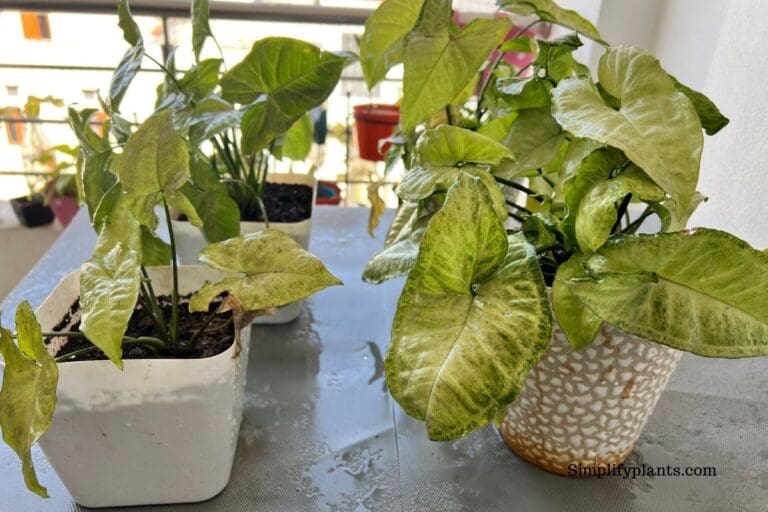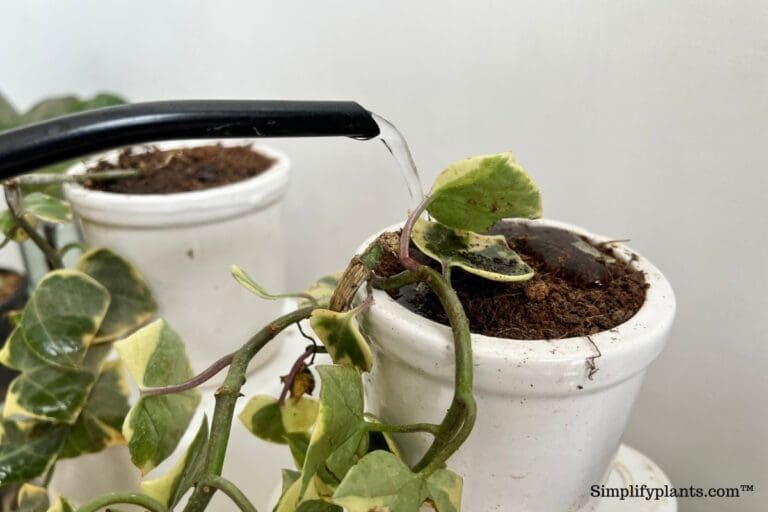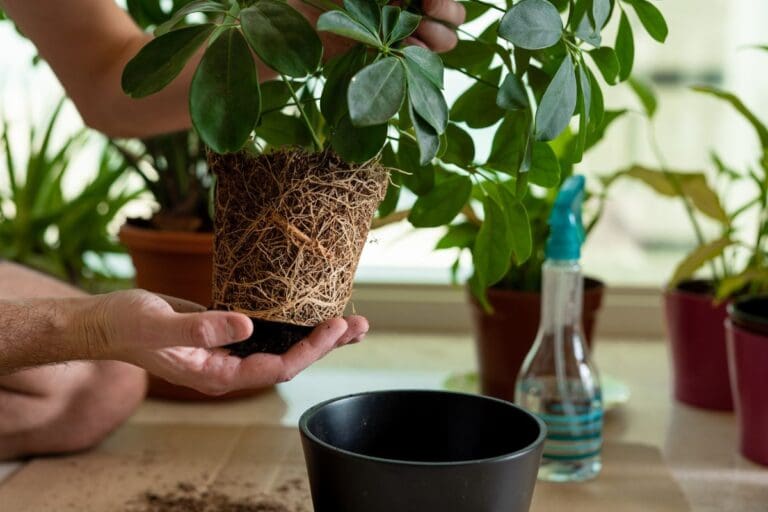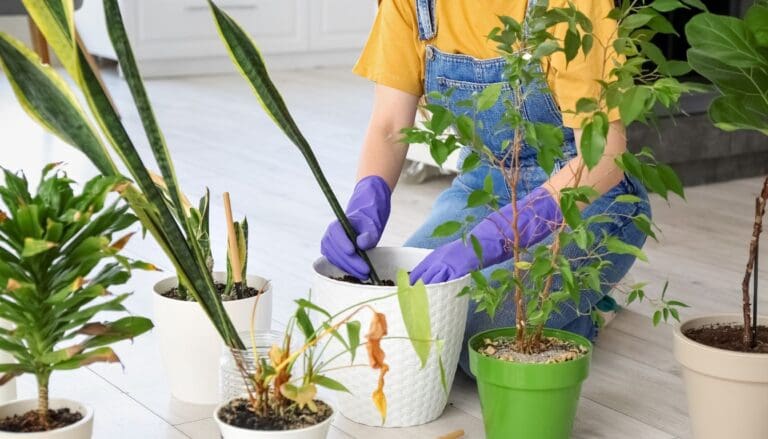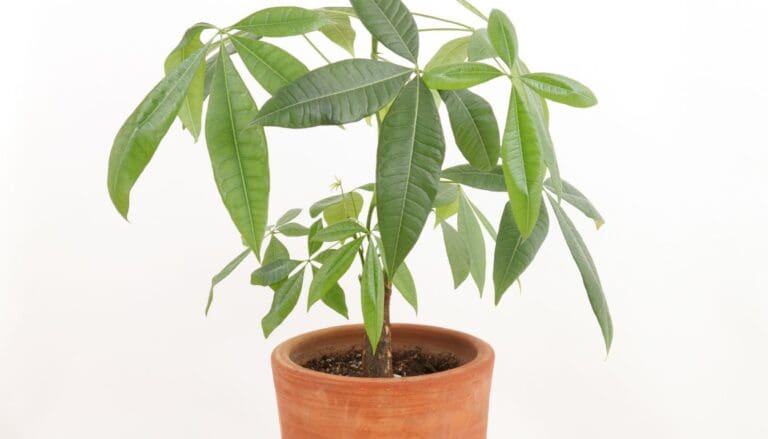White Spots On Rubber Plant? 9 Causes & Easy Fix
Have you ever noticed small, white spots in the leaves of your Rubber plant? If you have, you are not alone. Many houseplant lovers, both beginners and experienced, wonder and complain about such appearances on the lovely glossy leaves.
Several reasons can make white spots on your Rubber plants. Common reasons are overwatering, powdery mildew, pest infestation, sunburns, mineral and salt buildup, cold drafts, or cystoliths. Sometimes, it is nothing more than dust.
In this article, I will highlight each cause and easy solution to address the issue and bring back your precious houseplant. So let’s jump to the reasons without further delay.

Please note: Simplify Plants is reader-supported. Some links in the post are affiliate links and I get a commission from purchases made through links in the post.
1. Rubber plants have white spots due to overwatering
In this context, overwatering causes Edema.
Edema occurs when you water your Rubber plant frequently in high humidity and cool weather.
If you water excessively, roots may absorb water quickly, but plants might struggle to transpire through leaves.
High humidity levels make it difficult for the plants to transpire.
Since the air is already saturated with moisture, plants find it difficult to lose it.
Excessive moisture levels create pressure, making the leaf cells expand and burst.
As a result, water-soaked blister-like marks appear on the epidermis of the leaves.
The blisters erupt and cause brown or white spots on the leaves.
This condition is called Edema.
The condition results from multiple conditions: frequent watering, high humidity, reduced transpiration, and cool temperatures.
Fixing Edema in Rubber plants
Some readers have asked me how to fix overwatering in the Rubber plants a few years back.
I suggested to them the ways to revive their plant from overwatering.
But a few among them returned and complained about white spots after a few weeks.
Upon asking every detail, I understood it was Edema.
If you have similar issues, I recommend reducing the watering frequency for the Rubber plants immediately to prevent this issue from growing.
Since high humidity reduces transpiration, adjust the humidity levels.
Maintain at least 50-60% humidity levels around the Rubber plants.
Don’t let it cross 70%.
To reduce the humidity levels, install a dehumidifier, improve air circulation by opening the doors and windows, or run your air conditioner for some time.
While running the AC, ensure not to set the temperature to extremely low, and keep the plant 10 feet away from the unit.
Creating the right environment for your plant to recover from Edema will yield results in a few weeks.
2. Rubber plants have white spots due to powdery mildew
Rubber plants attract powdery mildew when the humidity is higher than 50-60% and the light is low.
The disease thrives in warm, humid, and dry conditions, especially when the plants are under the shade.
The pathogens of these diseases create white marks on the leaves.
It will seem like someone has scattered powder on the leaves, thus the name.
Over time, the leaves can turn yellow and brown, and the plant stunts its growth.
Signs of powdery mildew
- 1st Stage: You will see silver-greyish layers at the plant base spreading upwards.
- 2nd Stage: The white spots will progress and infect the new growths. It seems like scattered powder.
- 3rd Stage: The roots will dry, and your plant will die.
Solution to powdery mildew and leaf spots
First, stop spreading the spores to other plants by isolating your infected plant and removing the infected leaves.
Follow up with using organic fungicide.
It is an effective method to treat the disease without any chemical damage.
You can use sulfur, lime-sulfur, potassium bicarbonate, and neem oil.
You can make your homemade spray.
I have suggested this to one of my cousins.
Mix one teaspoon of baking soda with 4 cups of water and spray the mixture on the infected leaves.
Ensure that the spray contacts the fungus.
If the plant is badly infected, you can’t save it.
You must discard it to prevent the diseases from spreading to the other houseplants.
Improve air circulation if you have kept too many houseplants together.
Don’t let the leaves touch each other.
Ensure bright, indirect sunlight throughout the day.
Water the plant in the early morning to let it dry out by the end of the day.
3. Common pest infestations on Rubber plants can cause white spots

Common Rubber plant pests are aphids, spider mites, mealybugs, and scale insects.
Pests like mealybugs and cottony-cushion scales leave behind a cotton-like substance, which resembles white spots on the leaf surfaces.
Controlling houseplant pests in the Rubber plant
If your Rubber plant is infested with pests, here are some steps to take:
- Shower your plant to dislodge the pests.
- Spray some neem oil on the infected areas, mainly under the leaves.
- Wet a cotton ball with rubbing alcohol and wipe the leaves, especially where you can spot the bugs.
- You can handpick or use tweezers to remove the scale insects.
- Release beneficial predators, like ladybugs, lacewings, and hoverflies. They love munching such bugs.
- Use insecticidal soaps and pesticides if the infestation is too heavy.
4. Rubber plants have white spots due to sunburn damage
Rubber plants prefer bright, indirect sunlight. Excessive direct, high-intensity sunlight can scorch the leaves, thus making white spots on the surface.
These spots are identified as sunburns.
These leaves can also have yellowing and browning at the tips and edges if the plant remains exposed to direct sunlight for prolonged periods.
This primarily occurs when you move your Rubber plant from low-light conditions to a spot with intense sunlight.
Fixing Sunburn damage in the Rubber plants
I keep getting questions from people about Rubber plant leaf problems.
Most of them are due to improper light conditions.
The plant is either in the dark or standing in direct sunlight.
When you see scorching signs, check the sunlight intensity with your hand.
If it feels intense, I want you to relocate your plant to a spot with filtered sunlight immediately.
I advise acclimating your plant by gradually exposing it to filtered sunlight.
Since it has been in the shade, sudden sunlight can stress the plant.
South-facing windows provide too much sunlight in the summer.
Use sheer curtains to filter the light or shift it to west or east-facing windows.
Do the opposite in winter; you can skip curtains for south-facing windows as the intensity is relatively less.
Reduce watering and fertilizing if your plant has lost leaves due to sunburns.
But maintain a proper watering routine to keep the plant cool.
5. Rubber plants have white spots due to mineral buildup and fertilizer problems

Mineral deposits on the Rubber plants result from water impurities.
Tap water contains excess chlorine, fluorine, and other bicarbonates.
When you water the plant, these minerals and salts accumulate on the leaf surface.
Over time, these turn out as white spots.
Furthermore, this situation creates a favorable condition for fungus growth.
Over-fertilization also contributes to salt buildup.
When you fertilize the plant, every time, they leave behind some salts.
Thankfully, this gets flushed out from the soil with regular watering.
But during an over-fertilization, the salt buildup is so much that it doesn’t flush off with watering.
These salts accumulate in the soil, reach the roots, burn them, and hamper the absorption of nutrients and moisture.
White patches, spots, or scorch marks appear on the leaves due to overfeeding.
Removing salt buildup and fixing fertilizer issues in the Rubber plants
If you don’t have the issues I explained earlier, try changing the water and see how the plant reacts.
Stop using tap water and start using filtered or distilled water.
You can even use rainwater, provided you collect it directly into clean containers.
Rainwater dropping from the roofs is not suitable for use.
If you don’t have any other option than tap water, let the water sit overnight.
The harsh minerals will settle down and evaporate, and the water is ready to use.
To solve overfeeding issues, stop fertilizing and flush the soil properly.
Water the plant thoroughly until you see the excess coming out.
Let it dry a bit, and repeat watering. Do this 2-3 times until you see clean water coming out of the potholes.
Skip fertilizing until you see new leaves.
Later, fertilize only once a month during the spring and summer.
Skip in fall and winter.
If you don’t see any white spots, you have solved the issue.
6. Rubber plants have white spots due to cold drafts

Rubber plants enjoy warm weather conditions where the temperature should range between 60-80°F.
The frozen moisture in the plant expands and opens the cells.
The frost damage in the Rubber plants will create small white marks on the leaf surfaces.
The frosted plants will also turn the leaves brown and become prone to several pests and diseases.
Fixing frost damage on Rubber plants
First, remove the extremely damaged leaves and find out the reason behind the frost damage.
If the plant is close to the windows and doors from which cold air enters, remove your plant from such locations.
Close the doors and windows.
During the morning, let the plant have bright indirect sunlight for warmth.
If the plant is close to an air conditioning unit, move it to a warmer room.
If you have shifted your plant to a room containing a heating system, keep the plant 10 feet away from the unit.
Also, don’t set extremely high temperatures.
You can use heat mats to warm up the plant.
Another option is to use a 100W lamp designed for indoor plants in the interior of the Rubber plant.
7. Rubber plants have white spots due to nutrient deficiency
A lack of nutrients can stop the plant from manufacturing important molecules like chlorophyll, lipids, proteins, etc.
Nutrient deficiency for prolonged periods leads to stunted growth, diseases, chlorosis, and necrosis.
In the Rubber plants, white spots on the leaves with other signs, like dark green veins, yellowing, and necrosis, indicate a nutrient deficiency.
Here are some nutrients and results of their deficiency:
- Lack of iron causes chlorosis, where the yellowing starts in the veins. Slowly, the yellowing becomes white.
- Lack of calcium causes necrotic tissues in the new leaves. It begins with white marks and progresses to browning.
- Lack of magnesium manifests itself with yellow or white pigments on the leaves.
- Copper deficiency turns the leaves dark green, and the old leaves begin wilting.
- Manganese deficiency makes the leaf veins yellow, progressing to white over time.
Rubber Plant nutrition and care

I was discussing this issue last winter with one of my friends.
She wasn’t able to find out the actual cause.
Once she provided me with detailed information about her plant’s condition, I understood the issue.
When I asked her the last time she fertilized, I was surprised that it was one year ago.
I told her to fertilize the plant in the spring and summer with a light, balanced liquid fertilizer every 2-3 weeks.
After a few weeks, she happily informed me that her plant was back.
When you fertilize after a long break, water and moisten the soil well and start with low concentrated fertilizer in low amounts.
Slowly increase the dosage and amount.
A sudden application can shock the plant.
Remember that little is more.
It won’t harm your plant, unlike overfeeding.
Another problem could be the lack of proper nutrients in the fertilizer.
I have faced this issue a long time back.
No matter how correctly I fertilized, I always had white spots.
It was frustrating because everything was correct.
Upon deep research, I discovered some essential micronutrients were missing, and thankfully, I uncovered ways to adjust them:
- Use iron chelates for iron deficiency in the soil, or mix them with water and spray them on the plant’s surfaces. Another option is seaweed fertilizer.
- Add lime to increase calcium. Another option is crushed eggshells. Crush and mix them with the potting mix.
- Use dolomite fertilizer or Epsom salt to fix magnesium deficiency.
- Find a fertilizer containing copper sulfate or copper oxide to adjust the copper in the soil.
- Add zinc chelates to adjust the zinc content. Or, fertilize with fertilizers containing zinc sulfate.
Whenever you choose fertilizers, check the nutrients present. Also, use a fertile potting mix for the Rubber plants.
The fertilizers I love and also suggest to everyone are:
- Espoma Organic 8 Ounce Concentrated Indoor Plant Food. It has an NPK value of 2-2-2.
- Jack’s Classic Water Soluble All Purpose Fertilizer.
If you want natural fertilizers, use compost or worm castings.
Though it has a well-balanced mix that adds necessary nutrients, the ratios are inappropriate.
The best way is to mix organic and synthetic fertilizers and apply them every 4-6 weeks.
8. Dust on the Rubber plant leaves
The white spots you are seeing in your Rubber plant leaves are not any spots but dust.
The large waxy-like leaves can easily catch dust.
Not cleaning for too long will make these dust resemble white spots.
Excessive dust also hinders moisture loss and transpiration, therefore stressing the plant.
Clean the Rubber plants

You can shower your plant to remove the dust.
After showering, take a clean, dry cloth to remove the excess moisture.
Showering can be messy and quite an effort because you might have to lift the plant and take it to the sink or outside.
Instead, you can use baby wipes, wet cloths, or cotton swabs dipped in rubbing alcohol to clean the leaves.
Do this once every 1-2 weeks.
9. The white spots on the Rubber plants are Cystoliths or Lithocysts
I learned these terms much later from one of my expert gardener friends.
My Rubber plant leaves were having white spots, and I couldn’t find out the real cause.
I made all the adjustments I have shared above, but nothing worked. However, my plant was excellent and healthy.
One day, I was discussing houseplant issues with my expert friend and shared my issue with her.
That’s when I realized about Lithocysts and Cystoliths.
These white spots are called cystoliths.
They look like bugs, but they are calcium carbonate crystals that form in the leaves.
These calcified bodies in the leaves are accumulated by epidermal plant cells.
These are attached to the outer cell walls called internal silica stalks.
The term ‘lithocysts’ refers to cells containing calcium carbonate crystals, often seen as white spots.
Cystoliths are those crystals.
These white spots are the natural process of the Rubber plant’s growth.
These spots increase the plant’s capacity to photosynthesize by light redistribution, where it can process the light and feed itself efficiently.
These spots aren’t harmful.
The mineralization of plant leaves is a natural process and beneficial trait that has remained constant throughout evolution.
If your Rubber plant is healthy and well-developed and shows no other signs of stress but only white spots, it’s due to these crystals.
Don’t panic. No action is needed here.
Preventive measures and key takeaways for Rubber plant care
Once you have treated white spots on your rubber plant leaves, you must take further measures to prevent them from recurring.
Here are some preventive measures I always suggest these tips to my fellow readers who come up with such issues frequently:
- Let the Rubber plants have bright indirect sunlight throughout the day. It can reduce the chances of diseases, Edema, and pest infestations. Don’t expose it to direct sunlight. If the intensity is too much, use Venetian blinds and sheer curtains to filter it.
- Maintain a consistently moist soil, not waterlogged. Water in the morning to let it dry out by the end of the day. Avoid overwatering.
- Fertilize your Rubber plants monthly during spring and summer, but reduce fertilization in fall and discontinue it in winter. Use organic matter to improve its fertility.
- Temperatures should be between 60°F and 80°F. Protect your plant from cold drafts by keeping the doors and windows closed and maintaining distance between the cooling and heating systems of your room.
- Keep the humidity levels below 70% and above 50%. Use humidifiers and dehumidifiers to set the correct humidity levels. Use a hygrometer to understand the accurate humidity to make proper adjustments.
- Promote good airflow around your Rubber plants by keeping a reasonable distance around your plant and pruning overcrowded areas in your Rubber plant.
- Observe your plant daily to check out for pests and diseases. Concentrate on the underside of the leaves and stems and even soil. Early action can prevent the problem from spreading and keep your plant healthy.
- Whenever you see anything suspicious, isolate your plant because maybe there are eggs hidden that can increase the issue.
- Inspect your plant closely before buying to ensure you are not taking pests in your house.
- Occasionally, you can mist your Rubber plants with neem oil. It will retain humidity while keeping pests and diseases at bay.
- Always sterilize your gardening tools before and after use to prevent the spread of pathogens, spores, and diseases.
Final thoughts
There are various reasons for white spots in the Rubber plant leaves. You need to find the correct one by the signs besides white spots and fix them soon to keep it healthy in the long run.
Despite these issues, the plant is easy to grow. Good health is only possible when you give careful and much-needed requirements and attention.
Very few cultural practices are required – bright indirect sunlight, consistent moisture levels, well-drained and well-retained soil, warm temperatures around 60-80°F, and 50-60% humidity.
Consider regular pruning and increase airflow to improve the plant’s health. A routine checkup of the plant will help you know if the plant is stressed and how to overcome it.
You will be able to notice the signs that the plant displays and get enough time to remedy them.
If the white spots are not due to lithocysts and cystoliths, timely inspection and immediate action can protect your plant from potential problems.
With the correct cultural practices and a favorable environment for optimal growth, you will have a beautiful Rubber plant in your house.
What pests develop white spots on the Rubber plant leaves?
Mealybugs primarily cause white spots by leaving a white cottony substance on the leaves. So, whenever you see them, treat them immediately using neem oil, insecticidal soaps, or pesticides.
Can I remove the white spots?
You can’t remove the white spots on your leaves until you address the underlying issue. Sometimes, you must discard these leaves as they don’t turn green. It further promotes new leaf growth.
Reference: Rubber Plant Wikipedia
Recommended Garden Supplies
| Product Image | Our Recommended Gardening Supplies | Check Offers! |
|---|---|---|
Top Top
Top
Top
Top
Top
Top
Top
Top | rePotme Houseplant and Tropical Classic Potting Soil Mix | Check Offer On Amazon |
 Top
Top
Top
Top
Top
Top
Top
Top | Espoma Organic Indoor Plant Food | Check Offer On Amazon |
 Top
Top
Top
Top
Top
Top
Top
Top | GooingTop LED Grow Light 6000K Full Spectrum Clip Plant Growing Lamp | Check Offer On Amazon |
 Top
Top
Top
Top
Top
Top
Top
Top | Soil Moisture Meter | Check Offer On Amazon |
 Top
Top
Top
Top
Top
Top
Top
Top | Govee Hygrometer Thermometer, Bluetooth Enabled! | Check Offer On Amazon |
 Top
Top | LEVOIT Humidifiers for Large Room(Best For Plants) | Check Offer On Amazon |
 Top
Top
Top
Top
Top
Top
Top
Top | Upgraded DIY Automatic Drip Irrigation Kit, 15 Potted Houseplants Support | Check Offer On Amazon |
 Top
Top
Top
Top
Top
Top
Top
Top | Stainless Steel Heavy Duty Gardening Tool Set | Check Offer On Amazon |
 Top
Top
Top
Top
Top
Top
Top
Top | Bonide Insecticidal Soap | Check Offer On Amazon |
 Top
Top
Top
Top
Top
Top
Top
Top | Bonide 32 oz Spray Neem Oil for Organic Gardening | Check Offer On Amazon |
 Top
Top
Top
Top
Top
Top
Top
Top | Garden Safe Fungicide | Check Offer On Amazon |

